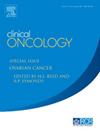Technical Aspects of a National Service for Paediatric Pelvic Brachytherapy
IF 3.2
3区 医学
Q2 ONCOLOGY
引用次数: 0
Abstract
Aims
Brachytherapy is advantageous for localised rhabdomyosarcomas in children compared with external beam radiotherapy, sparing close organs at risk with highly conformal dosimetry. A methodology for planning and delivering fractionated high-dose-rate paediatric pelvic brachytherapy is detailed, and the dosimetric parameters are presented. This provides a practical template for radiotherapy departments with a similar patient cohort to implement this treatment technique.
Materials and Methods
Patients with localised pelvic rhabdomyosarcomas underwent transrectal ultrasound image-guided transperineal percutaneous implantation of brachytherapy catheters or insertion of intracavitary applicators. Clinical target volumes were delineated on computed tomography imaging, extended cranially to form an internal target volume (ITV) to allow for perineal oedema, and peer reviewed. Dosimetry was manually adjusted to achieve optimal coverage. The prescription dose was 27.5 Gy in five fractions. The dose to 90% (D90%) of the ITV, and the conformity number (CN) were calculated. Replanning was undertaken if measurements or imaging showed suboptimal dosimetry due to internal anatomical changes.
Results
Thirty-five patients, aged 8 months to 17 years 6 months (median 2 years 10 months), were treated between 2009 and 2023. The median ITV was 18.5 cc. The median ITV D90% was 5.9 Gy per fraction. The majority of plans had a CN greater than 0.5. Replanning was required in two-thirds of patients.
Conclusion
Intraoperative transperineal interstitial implantation of flexible catheters, cervical intrauterine tubes, or vaginal applicators resulted in highly conformal plans, achieving excellent coverage with a D90% exceeding 90% of the prescribed dose in 34 out of 35 cases. Technical and practical measures are crucial for an optimal treatment for each child.
国家儿科盆腔近距离放射治疗服务的技术方面。
目的:与外束放射治疗相比,近距离放射治疗对儿童局部横纹肌肉瘤有利,在高适形剂量下保留有危险的近距离器官。一种方法学规划和提供分次高剂量率儿科盆腔近距离放射治疗是详细的,并提出了剂量参数。这为具有类似患者队列的放疗部门实施这种治疗技术提供了一个实用的模板。材料和方法:局部盆腔横纹肌肉瘤患者行经直肠超声图像引导下经会阴经皮置管或腔内应用器置入。在计算机断层成像上描绘临床靶体积,向颅骨延伸以形成内部靶体积(ITV)以允许会阴水肿,并进行同行评审。手动调整剂量测定以达到最佳覆盖率。处方剂量为27.5 Gy,分5份。计算ITV的90%剂量(D90%)和合格编号(CN)。如果测量或成像显示由于内部解剖改变而导致剂量不理想,则进行重新计划。结果:2009年至2023年间,35例患者接受治疗,年龄8个月至17岁6个月(中位2岁10个月)。中位ITV为18.5 cc,中位ITV D90%为5.9 Gy /分数。大多数计划的CN大于0.5。三分之二的患者需要重新计划。结论:术中经会阴间质植入柔性导管、宫颈宫内管或阴道涂布器可获得高度适形计划,35例患者中有34例患者D90%超过处方剂量90%,覆盖率极好。技术和实际措施对于每个儿童的最佳治疗至关重要。
本文章由计算机程序翻译,如有差异,请以英文原文为准。
求助全文
约1分钟内获得全文
求助全文
来源期刊

Clinical oncology
医学-肿瘤学
CiteScore
5.20
自引率
8.80%
发文量
332
审稿时长
40 days
期刊介绍:
Clinical Oncology is an International cancer journal covering all aspects of the clinical management of cancer patients, reflecting a multidisciplinary approach to therapy. Papers, editorials and reviews are published on all types of malignant disease embracing, pathology, diagnosis and treatment, including radiotherapy, chemotherapy, surgery, combined modality treatment and palliative care. Research and review papers covering epidemiology, radiobiology, radiation physics, tumour biology, and immunology are also published, together with letters to the editor, case reports and book reviews.
 求助内容:
求助内容: 应助结果提醒方式:
应助结果提醒方式:


